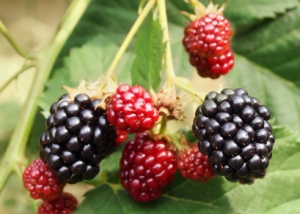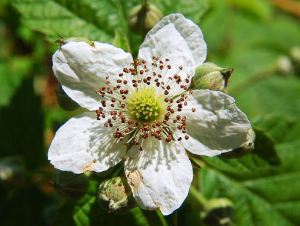 I love raspberries and blackberries, and grow red raspberries in the garden among my bounding mint patch. The berries only recently succumbed to hard frost, but were producing right up until it hit. My dear grandmother grew red raspberries and this variety is much like hers. I did a little digging and discovered more about the bramble family. Raspberries and blackberries are native to North America. Some kinds are thorny, others thornless, and there’s a wide variation in taste and color. They thrive in all 50 states and Canada.
I love raspberries and blackberries, and grow red raspberries in the garden among my bounding mint patch. The berries only recently succumbed to hard frost, but were producing right up until it hit. My dear grandmother grew red raspberries and this variety is much like hers. I did a little digging and discovered more about the bramble family. Raspberries and blackberries are native to North America. Some kinds are thorny, others thornless, and there’s a wide variation in taste and color. They thrive in all 50 states and Canada.
From Field Guide to Wild Plants by Bradford Angier, a wonderfully informative book given to me by my grandmother years ago. Mr. Angier has also written many other volumes. (This Amazon link takes you to the second edition of his book, I have the first).
“Juice and wine made from the berries is still used in Appalachia to combat diarrhea. The berries and their juice were long used by many Indian tribes to rid their members of chronic stomach trouble and to allay vomiting. It was considered effective in preventing miscarriage. It is astringent and believed generally beneficial to digestion, being thought mild enough to control diarrhea and dysentery even among infants and children. Early Americans sometimes combined it with honey and alum to tighten loose teeth. The settlers also came to use the juice to dissolve tartar on the teeth. It was turned to by numerous tribes to cure cankers of the mouth and gums.
 The juice was also turned to by many Indians and pioneers to lessen menstrual flow without suddenly ending it entirely. When the bowels were loose it was drunk instead of tea or coffee. It was thought to ease nausea, be an antacid, and act as a parturient (aids in birth). Many a colonial deemed his medicine chest incomplete if it did not contain blackberry brandy or cordial.”
The juice was also turned to by many Indians and pioneers to lessen menstrual flow without suddenly ending it entirely. When the bowels were loose it was drunk instead of tea or coffee. It was thought to ease nausea, be an antacid, and act as a parturient (aids in birth). Many a colonial deemed his medicine chest incomplete if it did not contain blackberry brandy or cordial.”
This is how strongly they believed in its curative and stomach soothing properties, which I can also vouch for. Blackberry leaves were gathered after the dew was off them, dried at room temperature, not in the sun, and stored in tightly capped jars in dark cupboards. A level teaspoon of the dried leaves were steeped in a boiling cup of water, then drunk cold, 2 cups a day, as a tonic or blood purifier. It was thought helpful to give to mothers in childbirth and during delivery. A potent tea was applied to sores and used as a gargle and mouthwash. Strong healing teas were also made from the blackberry roots and bark (steeped fresh, or from the dried bark/roots) as a tonic, for treating diarrhea, upset stomachs, whooping cough, labor pains…
An old standby from the McNess Company is great for soothing troubled digestion. McNess salesmen used to go door to door, and we had a kind elderly gentleman, but they no longer do. It’s called Aromatic Compound and is a liquid medicinal blend made from extracts of blackberry, rhubarb, and ginger with anise and clove oil. If you’re interested in getting a bottle, visit the link to their site.
 Anne of Green Gables fans will remember the scene (I watched the series) where Anne is delighted to host a tea party for her friend Diana. She’s particularly proud to serve a special bottle of Marilla’s raspberry cordial, but mistakenly offers Diana currant wine, not meant to be imbibed by the tumbler full (3 of them) as it’s alcoholic. The inevitable happens and causes much distress, which is eventually overcome. Those of you interested in making raspberry cordial, and/or catching up on Anne of Green Gables, will enjoy visiting this blog post:http://thehistorykitchen.com/2012/07/20/anne-of-green-gables-raspberry-cordial/
Anne of Green Gables fans will remember the scene (I watched the series) where Anne is delighted to host a tea party for her friend Diana. She’s particularly proud to serve a special bottle of Marilla’s raspberry cordial, but mistakenly offers Diana currant wine, not meant to be imbibed by the tumbler full (3 of them) as it’s alcoholic. The inevitable happens and causes much distress, which is eventually overcome. Those of you interested in making raspberry cordial, and/or catching up on Anne of Green Gables, will enjoy visiting this blog post:http://thehistorykitchen.com/2012/07/20/anne-of-green-gables-raspberry-cordial/
No comments:
Post a Comment